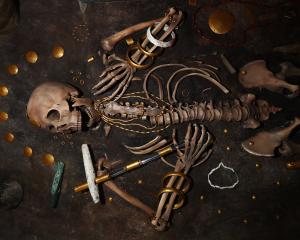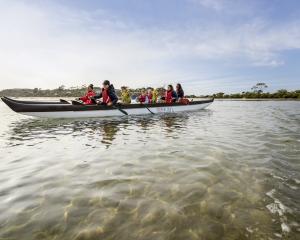For a boy at the old stone Port Chalmers Primary School, in Ajax Rd, in the 1930s there was always one major question?Who would get to sit on the side of the classroom furthest from the windows so they could watch the steam locomotives grinding up the Mihiwaka incline, on the main trunk line north from Dunedin.
Doug Wright, recently turned 80, remembers the view well - "a glimpse" of an AB, a JS a WAB or perhaps even a Baldwin Q.
And from his home, high on Constitution St, he also had a view of the harbour all the way to "the heads", complete with a grandstand seat above the activity on the wharves.
"You had the woolsheds where you could see them dumping the wool, compressing it, and then they'd take it around to the ships, and they'd be loading frozen meat and there would be butter and that sort of stuff.
"I think the butter in those days went away in white pine or kahikatea boxes."
The meat would be loaded one frozen carcass after another, lifted out of a railway wagon by one "wharfie", dropped on to a chute that would carry it down to another ready to load it into a sling.
And when the sling was full, it would be swung across the ship's deck and into the hold where it would be unloaded manually and the carcasses put into refrigeration chambers.
Sometimes live sheep were loaded for farms in the Argentine.
"And then, you would have all the general cargo coming out and that could be anything from galvanised iron to big British cars like Rovers.
"They all came out in crates like a big wooden garage.
They were lifted off with the ship's gear and put on the wharf or on to a railway wagons."
Growing up surrounded by such activity, it is not surprising a young boy from Port Chalmers should develop a strong interest in the machinery of the port.
But, for Doug Wright, it has become something of an obsession.
The compact office of his home is an archive of details about ships and trains that have come and gone for more than half a century.
It has floor-to-ceiling files and shipping registers and boxes full of black and white and colour prints and negatives.
Doug Wright's first love, after his remarkably cheerful wife Margaret, of course, is rail.
He wanted to be a locomotive driver when he left school but was talked out of it by a senior engine driver at the port who said he would never be home.
He also wanted to be an electrician, but such jobs went to servicemen returning from the World War II.
So, he went painting, first for Love Construction and later for the Union Steam Ship Company.
That involved painting the interiors of cabins and the hull "draught marks" on ships in the dry dock, a job that sometimes produced a bonus.
"The odd time a heap of fish would arrive in the dock.
Red cod or something like that."
Scraping off or slapping on lead paint might have been his trade, but always there was time for his main preoccupation - recording trains and ships.
"It suited me to be in port because I could zip away on my bike to take photos, but I always made up the time."
He, and others with a similar interest, would endeavour to take their photos in time to catch the splash as the anchor dropped.
In August 1954, Doug Wright's new, part-time, career began when, as "the Bo'sun" he had his first "Ships and the Sea" column published in the Evening Star newspaper.
A rather tattered "thumper scrap book" holds a clipping that records the imminent arrival of MS Cragmoor and the presence, at the George St south wharf, of MS Cumberland - the former a ship of 5252 tons and the latter 11,281 tons.
Incidentally, Mr Wright doesn't hold much with the modern word "tonne" or with sub-editors who think the two words are interchangeable.
"And, I hate Mr and I hate Douglas."
Mr Wright took over the column from a wharfie who was "going to toss it in".
Once a week, the young Mr Wright would run from the railway station up to the first floor of the Evening Star and hand his column personally to a sub-editor.
The "subs" would have a bet on how many paragraphs he had written.
Asked why they would do that, Mr Wright said: "I'm damned if I know".
Mr Wright's column is now delivered to the Otago Daily Times weekly by email rather than by steam train, but his reputation for accuracy and punctuality remains.
ODT regional editor Dave Cannan considers Mr Wright could have been a journalist.
"He is very news focused . . .
He is one of those guys who sees things happening and wonders why they are happening."
On one occasion, he rang Mr Cannan to say a particular train that always passed at a particular time had failed to do so.
"And he wondered if we should find out why.
"It had been in a collision further up the track.
"Because he is observant and interested and curious he thought it was worthwhile ringing and telling me in that wonderfully rich, vibrant `Doug Wright' voice of his.
`You knew there would be very little going on in Port Chalmers, either shipping-wise or train-wise or anything, he wouldn't have heard about or know about and he felt a tremendous obligation to the ODT to ring us and tell us."
"One of those real characters. We could do with one of those in every town."
Oddly enough, for a man who has written about 2800 columns on shipping over 55 years, there was a time when ships did not greatly interest him.
During World War 2 they were invariably painted grey and it was only once they began turning up in their "peacetime colours" that Mr Wright took much notice.
"Of course in the paper in those days they had a lot of stories about those that were sunk in the war, new ships coming out; being built and that sort of stuff."
Mr Wright says shipping news was a major part of newspapers after the war, with details from all the ports around the country, including even the names of ships' captains.
And the ships of the time were admired for their lines and their rigging - general cargo ships like the City of Auckland, the Chardina, the Huntingdon, the Carnatic and the Akaroa, with its vertical stem, its raked masts and its counter stern.
"See, I like that old Akaroa. It's got a style about it.
"They had all the masts and the derricks and all the gear on them. They looked like a ship."
Mr Wright has recorded the details of every ship that has visited Otago Harbour since the end of the war.
His favourite was QE2.
"She was the iconic Cunard. Of all the ships I've photographed - I've photographed about 3600-odd ships here - she would be the one that stands out."
Mr Wright posed, reluctantly, for the Otago Daily Times next to the Star Princess, unimpressed by its stern and the exhaust "plumbing" that stands where a funnel should.
Mr Wright said he "mourned" the passing of the old ships - replaced by the car carriers, "terrible looking things", the cruise ships, "there's nothing beautiful about them really" and, of course, the featureless container ships.
Mr Wright may prefer the older ships, but has not become stranded in the past, still managing to find something current to write about.
His old Imperial typewriter has been replaced by a computer and now he has a bevy of obscure maritime websites at his fingertips for elusive facts and figures and for leads on shipping stories that have an Otago connection.
"There's stuff comes through every day. A lot of it's of no particular interest here. But sometimes . . ."
Mr Wright has had only one short break from his column, when he "tossed it in" in 1973.
Within months, he had rung to correct an inaccuracy he had spotted in a report about a ship berthed at the "cross wharf", had been persuaded to help out, briefly, in the holidays and was back behind his typewriter turning out the "On the Waterfront" column for the Otago Daily Times' .
"And I've been going ever since. They're still putting up with me."












